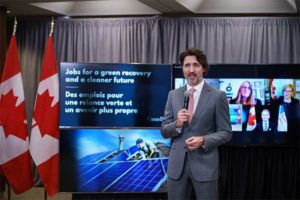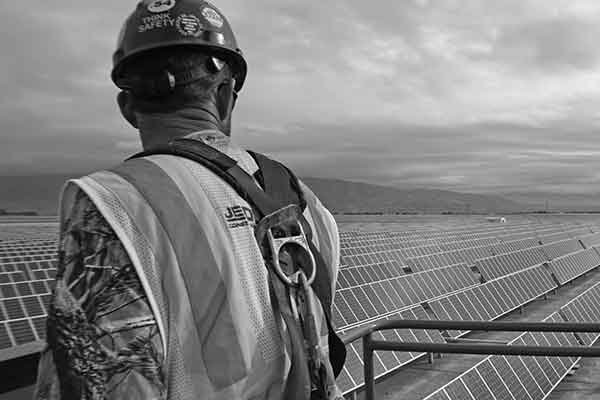According to new research from TD Economics, Canada’s financial support for the clean energy transition is competitive with the Inflation Reduction Act (IRA) south of the border.
The analysis published on Monday largely refutes the claims advanced in recent months by Canadian industry leaders who have positioned the US IRA as the gold standard in the global contest for energy transformation investment.
According to TD, the government of Canada has spent $139 billion on clean energy development subsidies since budget 2021, or 5% of the country’s nominal GDP.
According to the bank, this compares well to the expected US$393 billion in spending under the Inflation Reduction Act, or 1.5 percent of the country’s nominal GDP.
“Despite criticism, Canada’s financial support for the clean energy transition is yielding positive results and has established a competitive position relative to the US,” TD managing director and senior economist Francis Fong stated in the research.
The IRA, signed into law by President Joe Biden last year, is the most ambitious piece of climate legislation ever enacted in the United States. It provides around US$375 billion in new and extended tax credits for everything from renewable power generation to hydrogen production to sustainable jet fuel usage to assist the US clean energy industry in getting off to a good start.
Some Canadian corporations have stated that the incentives in the United States are so appealing that it is hard to compete.
Parkland Corp., based in Calgary, announced in February that it would abandon plans to build a standalone renewable diesel complex at its refinery in Burnaby, B.C., partly because the company believes the IRA’s incentives favour producers south of producers the border.
According to Bob Larocque, president and CEO of the Canadian Fuels Association, other corporations are on the point of abandoning their Canadian project ideas.
He explained that this is because clean fuel projects in the United States are eligible for a guaranteed tax credit on their fuel output, whereas in Canada, the industry received nothing more than a vow for additional consultations in the most recent federal government.
“We have $10 billion of announced investment in Canada over the last two years, which are all being re-evaluated due to the impact of the IRA,” said Larocque, president and CEO of the Canadian Fuels Association, in an interview.

Prime Minister of Canada Justin Trudeau announcing that his governments will recruit, train, and mentor up to 2,000 of them across the country.
Ottawa, for its part, has been clear all along that it needs to do more to compete with the US in clean energy development.
Finance Minister Chrystia Freeland made promises for investments in clean electricity, cleantech manufacturing, and hydrogen in the federal budget last month, totalling $55 billion through the fiscal year 2034-35.
However, Michael Bernstein, executive director of the climate policy organization Clean Prosperity, believes the issue isn’t how much Canada spends but how it spends.
He stated that Canada had committed billions of dollars to programmes such as the Net Zero Accelerator, the Strategic Innovation Fund, and the Canada Infrastructure Bank. In exchange, all of these organizations have been tasked with developing funding bids that meet Canada’s climate goals.
However, Bernstein believes this type of system is not as effective as a clear-cut system of tax credits, such as the one in the United States.
“It’s great that there are tens of billions of dollars in these various funds,” he added, “but if I’m an investor — say, a proponent of hydrogen — I have no idea what that means for my facility.”
“I have no idea how much I’ll get, whereas in the US it’s very clear.” There’s this upfront certainty about the kind of support I’ll receive from the federal government.”
According to TD research, regardless of overall cash amount, per-unit subsidies in Canada are, in some circumstances, much lower than their counterparts in the United States.
“However, this has not stopped Canada from securing significant domestic and international investments,” Fong said, adding that TD believes Canada has received $17.4 billion in investment announcements for electric vehicles and battery plants since 2021.
The federal government just agreed to up to $13 billion in subsidies over the next decade to help Volkswagen develop its first overseas battery manufacturing plant in southwestern Ontario.
“Subsidies and climate policies do not solely determine Canada’s position in this supply chain,” Fong explained. “Importantly, close proximity to critical minerals is one of the primary draws of investment initiatives.”
According to the TD analysis, Canada has a carbon pricing scheme while the US does not, so US subsidies must be bigger to make investing in clean energy economically viable.
TD argued that the greatest threat to Canadian competitiveness is not a lack of government money but a shortage of trained talent and the lengthy period it takes to build significant infrastructure projects in this country.
According to the paper, Canada should prioritize project assessments, shorten mining development timeframes, and refocus policy on labour force skills and training if it wants to attract renewable energy investment.
—
This article is adapted from an originally published version by the National Observer on April 25, 2023.













Comments